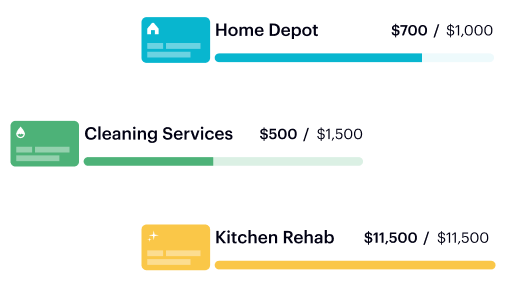The Ultimate Guide to Real Estate Investing
This step-by-step guide to real estate investing will tell you how to get started, the pros and cons of some of the most popular real estate investment strategies, how to find quality properties, as well as the benefits and risks of generating passive income with real estate.
How to Start Investing in Real Estate
If you want to become a real estate investor, there are several steps you can follow to help you get there. A lot of the work begins before you even buy your first property, but figuring out the direction you want to go in can save you a lot of trial and error down the road.
Below, you can learn more about how to start investing in real estate.
1. Set Realistic and Actionable Goals
The first step to real estate investing is figuring out what you want to get out of it. Your goals should be specific, realistic, and actionable. They should also give you the blueprint for your next step. These can be things like, “I hope to make a profit of at least $1,000 a month within the first two years of buying a property,” or “I want to buy 10 properties that each yield $200 per unit a month after expenses in 3 years.”
2. Partner with a Real Estate Mentor
If real estate investing is new to you, the best way to ease into it is to team up with a seasoned investor who knows your market and can give you valuable advice drawn from their years of experience.
By talking to them and learning from their experience, you may even be able to avoid some of the mistakes that they themselves have made, thanks to their advice and the benefit of their hindsight.
Finding a mentor is now easier than ever, reach out to your personal network, join real estate investor forums and groups on Facebook and LinkedIn or join real estate investment groups in-person and you’ll find like-minded people to help you out.
3. Research the Market
To know how well your real estate investments will do, you must understand the market. The best way to do this is by evaluating historical market data alongside current trends.
Real estate is cyclical and, as a result, its supply and demand nature is influenced by economic trends. If you’re able to look at data over several decades to see how the market has both changed and stayed the same over the years, you’ll have a better understanding of the market overall.
Speaking with local real estate brokers, investors, and agents will give you the most up-to-date information on the market and potentially grant you an inside glimpse into any changes, upswings, or downturns.
4. Choose Your Investment Strategy
There are several ways to invest in real estate beyond just renting out your property and becoming a landlord. Before you invest in real estate, you need to decide on a strategy. Below are some of the most common:
House Flipping
As seen on TV, house flipping is when an experienced real estate investor (someone who knows the local market in terms of what properties are worth and what they can be sold for) buys a distressed property for lower than market value, renovates, and refurbishes the property up to current market standards. They then sell the property for a profit.
It should be noted that house flipping is not an investment strategy for beginners. If you jump right into it without knowing the real estate market, it could be very risky. You must also have connections with quality contractors like electricians, plumbers, interior designers, and more.
How to fund: Self-funded, limited partnership, private lender
Down Payment Required to start: 20% to 25% of the purchase price
Expected Return over time: ~40%
Become a Landlord
If you’ve purchased a property and are renting out all our part of it, you are a landlord. It’s the classic way to invest in real estate, earn extra income and get several tax breaks.
However, managing a property takes a huge time investment in collecting deposits, executing leases, paying for maintenance and repairs, and rent collection.
Thankfully, there are various technology platforms that could help you with that last one, including Baselane, which can manage your banking, put collecting rent on autopilot, and help you easily analyze your cash flow so you can focus on scaling your portfolio.
There are two primary ways to purchase a rental property, each with its own pros and cons:
Buying Turnkey Properties
This method is exactly what it sounds like. You purchase a property that’s brand new or in very good condition and ready to rent with little to no modifications required. The effort here comes when you’re doing your due diligence while finding and buying the property.
After that, your time and effort managing the property are only a few hours a month at the most, especially if you hire a property manager or management company to take care of the day-to-day or invest in software that can help you with your finances.
The big risk here is that you’re largely trusting the success of your investment to other people. Additionally, if you want something done right, you may have to do things yourself.
Plus, your profit margin potentially won’t be as high when you sell a turnkey because turnkeys usually sit at market value and there’s not much that can be done to really raise their value in the near term.
How to fund: partnerships, private lending, self-funded
Down Payment Required to start: 5% to 20%
Expected Return over time: 11.1% (average year-over-year)
Doing the BRRRR (Buy, Rehab, Rent, Refinance, Repeat)
BRRRR is a strategy where you buy a distressed property for lower than market value, fix it up and make it worth more than your purchase price (forced appreciation).
The problem is, just like with house flipping, if you don’t know what you’re doing (or know how to outsource to people who do) you increase your risk.
In addition, renovating a home up to today’s standards could take a lot of time and effort, especially if it’s your first time. Plus, it may cost you more money upfront with more expenses due to the rehabilitation.
Still, you do get more control over the final product and will be able to guarantee results that match your standards and preferences.
How to fund: Self-funded, partnership, refinancing, private lending
Down Payment Required to start: 0% to 20%
Expected Return over time: Variable depending on the market, expect higher than turnkey
Wholesaling
Real estate wholesaling is when you arrange the sale of a seller’s distressed property to another real estate investor for a fee.
Fees generally range from $5,000 to $10,000, which may not sound like much, but deals can close quickly and if you’re good, you can close two or three at a time.
There’s no need to invest cash, it’s a great strategy for beginners and there’s no management or maintenance. However, it doesn’t offer regular income, and finding the right property and a collection of reliable buyers can be really difficult at first.
How to fund: Self-funded
Down Payment required to start: zero to a few thousand for marketing the properties
Expected Return over time: $5-10K per deal on average (ROI is variable depending on how much money and time you invest)
5. Find the right property
Find a property that fits your chosen investment strategy. In general, you should look for one that’s likely to appreciate over time. Small cosmetic repairs could make a big difference in a cheaper property’s ability to appreciate, so your chosen property doesn’t necessarily have to be new to be a good investment. Also, remember you can apply for property tax rebates to cover some of the costs.
6. Get the financing together and make a purchase
You might be concerned about whether you can afford your selected property. Some people use a home equity loan (a loan based on the difference between the value of your current home and what you still owe on your mortgage) to finance their income properties.
A second mortgage is also possible, but mortgages for income properties generally require a larger down payment of 20% unless they are owner-occupied (Then, all you need is five to ten percent).
If you don’t have the cash required to get started, you can establish a joint venture or partnership where your role is to run the deal and manage the property, while your partner handles the costs and you split the profits however you like (e.g. 50/50).
How to Find the Best Real Estate to Invest In
The types of real estate investments depend on the investment strategy you’ve chosen, your budget, your intentions for the property, and your overall financial goals. To find your diamond in the rough, there are several resources you can exploit:
Network with real estate agents, developers, and other investors
Partnering with other, more seasoned, real estate investors is a great way to key in on properties that may match your financial goals. Develop your relationships with them enough and they may even sell you properties in their investment portfolios.
Having contacts who are agents and developers can tip you off to hot properties before they are listed and may even get you in on a private sale where you are the only bidder. Join real estate clubs, go-to real estate networking events, and join real estate forums and groups on Facebook, LinkedIn, and Reddit.
Tell people you are in the market
Sometimes the simplest strategies are the best and nothing gets you what you’re looking for like word of mouth. Tell everyone in your social circle, including friends, colleagues, and relatives, what you are looking for, but be specific about it.
Tell them exactly the kind of property you are looking for and the area you want it to be in. Explain that if they hear of a seller with a property that matches your criteria, they should think of you before anyone else. They may even sell to you themselves one day.
Drive around your target neighborhood
Some call this “Driving for Dollars,” but it’s still a good way to find unlisted properties where you’ll have no one to compete with.
Looking for properties with slight signs of disrepair, like broken windows, peeling paint or overgrown lawns may be an indication an owner is neglecting their property because they want to sell. Look up their phone number, send them a letter or walk right up to the door and ask them while casting yourself as the interested buyer.
Search online and on social media
This might be rather obvious, but there are tons of investment property listing websites out there. Facebook Marketplace has also become a great way to search for properties and some real estate deals these days are sight unseen over Instagram or TikTok. If you want to get in on a property, you have to be where it’s listed. If you have a good relationship with some top agents in your area, they may even give you access to realtor-only listing spots like MLS.
Call “For Rent” Signs and Craigslist Rental Listings
If you call a “For Rent” sign or a Craigslist rental real estate listing, you never know when you’ll run into a landlord who’s tired of the headaches of being a landlord and is interested in selling, especially if the same property has been listed on the market for a while with no renters to come by.
Of course, once you’re able to take over as landlord on one of these properties, platforms like Baselane ensure you never experience those same headaches down the line because it can help you seamlessly manage your cash flow and take care of landlord tedium like rent collection.
How to Make Passive Income with Real Estate
For those who don’t want the day-to-day or even month-to-month responsibility of actively maintaining a property as a landlord, don’t want to have to renovate and prepare a property for sale as a house flipper and don’t want to even arrange a real estate transaction as a wholesaler, but still want a share of the money real estate can generate, there are various ways to earn real estate income without taking an active role in a property’s management.
Real Estate Investments Trusts (REITs)
Real Estate Investment Trusts (REITs) are a way to generate passive income by investing in real estate. They allow you to own a piece of commercial real estate without owning actual buildings for as little as under $10 per share
In this instance, you invest by purchasing shares in a real estate company that owns the property and get a share in the profits from any property sales or rentals. This is a great way to invest in real estate without the landlord’s responsibilities of maintaining a property.
According to Nareit, the global organization representing the interest of REIT investments, the typical return averages to 9.9% over 20 years but can be as high as 11.15%. This is because custodians of REITs must distribute 90% of the profits from properties within them in the form of dividends to investors by law, so returns can be high as a result.
Still, investment fees can eat into your return and you don’t have any control of your investment. REITs are easy to access though, as they can be purchased through a REIT ETF and set up by your investment advisor or a discount brokerage like Questrade or WealthSimple that can invest in stocks for you.
How to fund: Self funded
$ required to start: Under $10 per share
Expected Return over time: ~10%
Where to invest: Your broker (Schwab, Robinhood)
Real Estate Crowdfunding Platforms
These are platforms where real estate developers who need funding to finance their own properties can appeal to the masses to invest in their projects in exchange for quarterly payouts, regular dividends, and hopefully, consistently appreciating value.
Even though it’s relatively easy to join in, crowdfunding platforms often require you to be an accredited investor to participate, which means you are capable of taking on riskier investments beyond your typical securities.
To be deemed an accredited investor, you will need to have $200,000 in annual income (or $300,000 with a spouse) for the last two years with the same or higher expectations for the current year and a net worth of $1 million or higher. The minimum investment required is usually high, such as $25,000 to $100,000 (depending on the property) on platforms like CrowdStreet. However, companies like Fundrise have a very low minimum starting investment at $10 or $1,000.
Typical returns are between 9% and 16% depending on the platform you invest with. Remember though, these platforms are a dime-a-dozen, so you need to do your due diligence and have enough market knowledge to know what you’re getting into (look out for expected return, fees, investor requirements, online reviews, etc.)
How to fund: Self funded
$ required to start: $1,000 to $100,000
Expected Return: 9% to 16%
Fees: 1%-2.5%
Where to invest: Fundrise, Crowd Streaty, RealtyMogul
Joint Ventures and Partnerships
Joint ventures and partnerships through the formation of LLCs are a good way to divide and conquer the passive and active roles in real estate investing based on each partner’s skill set and interests.
One partner can handle the active management of properties, while the other passive partner contributes their contacts, financial capital, and experience in exchange for a share of the profits and tax benefits.
The benefits of joint ventures and partnerships are they spread the risk of real estate investing. Plus, two heads and two contact pools are always better than one.
However, partnering with someone does split the profit you can earn, and you must assume a certain amount of risk anytime you’re relying on someone else.
Having a partnership agreement will mitigate that risk somewhat by spelling out the terms and expectations of the partnership in writing. A site like Rocketlawyer.com can provide a quick partnership agreement template if you need one. (Rocket Lawyer legal documents only apply to U.S. law)
Turnkey Properties
We addressed this a little bit earlier, but if you buy a turnkey and set up its management in the right way, this can be a great passive income option.
The four key things you need are (1) a clean property with no repair or maintenance issues, (2) a property that meets the target returns based on your goals, (3) a good property management company to manage tenant relationships and the day-to-day demands of rental properties and (4) a platform to help you manage your finances and grow. If you have these four things, the most time you’ll ever have to dedicate to your investment is a few hours (and that’s if things are at their worst) the rest of the time, you just pay your expenses and watch the money roll in.
Final Thoughts on Real Estate Investing
When you want to get into real estate investing, there are several ways to make that happen. The strategy you choose should depend on whether you want to be an active or passive investor as well as your skills, your investment goals, your budget, and your plans for any properties you buy.
There are pros and cons to every strategy and various ways to find the properties that fit your plans. With your options, it is important that you do indeed have a plan, a clear idea of your financial goals, and how your real estate investment strategy can help you accomplish them.
FAQs
Investing in anything is risky to some degree and that’s no different with real estate. You need to assess your risk tolerance before you start investing in real estate, as you would with any investment, and choose an investment strategy that matches your risk tolerance.
For example, if your risk tolerance is low, you’ll likely want to be a more passive investment that collects your share of the profit but doesn’t have to make any of the management decisions for maintaining a property.
However, if your risk tolerance is higher, perhaps you’ll want to be directly involved in fixing up a property and trying to sell it at a profit. Do what you can to mitigate your risk where necessary, whether that’s partnering with others to spread the risk among many people or purchasing your property under the guidance of a more experienced real estate investor.
Overall, real estate is a great investment. It appreciates in value over the long-term and has the power to generate passive income to the point where you as the investor do very little.
However, you must be ready to invest in real estate because it requires a significant amount of money upfront, good to excellent credit, and will bring you ongoing extra expenses.
Hopefully, those expenses are mitigated to some degree by the income you are generating, and you can still make a little profit on top of them. But investing in real estate can still be incredibly complex for a novice investor.
You’ll also have to have enough money set aside to prepare for income gaps if you choose to be a landlord and you’re without a tenant for time. Generally, the rewards outweigh the risks, and many investors find putting their money in real estate extremely fulfilling.
How much you need to invest in real estate depends on the investment strategy you’re going with.
For example, if you’re going the passive investor route through a REIT, you’ll need the least amount of money to buy in at between $1,000 to $25,000 or more. It gets a little higher with a joint venture or partnership at between $5,000 and $50,000.
However, if you want to be a landlord of a rental property, you’ll likely be investing the most due to the ongoing maintenance and other expenses you’ll always have.






